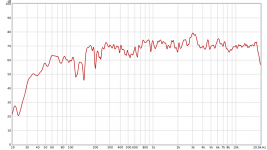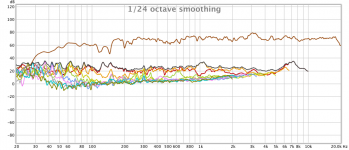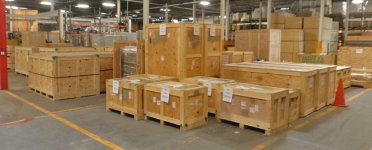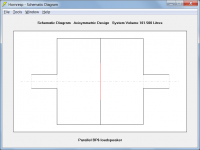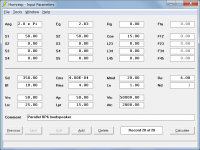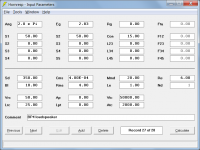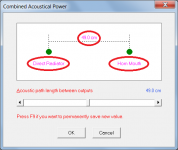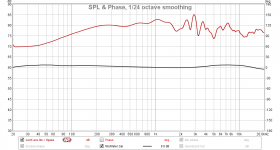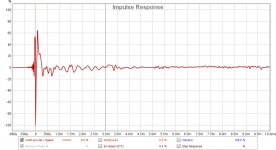So I figured out the boominess on mine was the home theatre receiver I was using had a loudness, aka +10db at 100hz turned on which could only be flipped via the remote. I decided to get a measurement before I added the port. This is a single 3.3uf cap on the tweeter as the entirety of the crossover. 1/24 smoothing.
I am tempted to run the woofers in parallel instead of series.. not sure the tpa3116 amp I use for testing will like that though...
I am tempted to run the woofers in parallel instead of series.. not sure the tpa3116 amp I use for testing will like that though...
Attachments
Last edited:
This is an attempt to smooth the FR out a little more.
I created the FRD and ZMA files (REW export) for the woofer in the cabinet. Loaded them into Xsim with the files for the TD20F and played with the XO points until I got it as smooth as I could.
I also went in and added acoustic tile to the back (behind the woofer) and fibreglass fill to the bottom (port is not blocked) to dampen internal resonances and reflections. It had very little effect.
Included is the Xsim prediction and the actual measurement. I think that's as good as I can get it. Suggestions welcome.
Was the actual measurement the in room measurement? It seems that the low end is showing room modes, that weren't in the crossover modeling. Could you post a gated measurement?
Tony.
Jared, Paralleling up the woofers (provided the impeadance is still ok) might work, but I suspect you will end up needing to add an inductor. Certainly doesn't cost anything to give it a try!
Tony.
Tony.
Was the actual measurement the in room measurement? It seems that the low end is showing room modes, that weren't in the crossover modeling. Could you post a gated measurement?
Tony.
When I measure the driver in the cabinet (for Xsim) it's near field and gated to exclude the baffle and port. My speaker in room measurements are gated [-50/100ms and 8 cycle FDW] taken at 0.5m to include the port effect and baffle that's why you see the LF extension. Limiting room modes is difficult but I have a measurement placement and arrangement that controls them to a large degree. I'm now thinking it could be box resonance, the baffle or floor reflection that is causing that bumpy response.
Last edited:
So I figured out the boominess on mine was the home theatre receiver I was using had a loudness, aka +10db at 100hz turned on which could only be flipped via the remote. I decided to get a measurement before I added the port. This is a single 3.3uf cap on the tweeter as the entirety of the crossover. 1/24 smoothing.
I am tempted to run the woofers in parallel instead of series.. not sure the tpa3116 amp I use for testing will like that though...
What drivers are you using ?
These poly buyout $5.88 ea
6-1/2" Poly Cone Midbass Woofer 4 Ohm
and GRS mylar tweeter $2.90 ea
GRS 1TM-4 1" Mylar Tweeter 4 Ohm
and the caps I pulled off of car tweeters so unsure how to value a used 3.3uf 35v capacitor.
I posted pics earlier in the thread. For $15 ea though, I am pretty pleased as they sit, and they are in largish boxes sized for a 3" dia 6.7" long port I have just not added yet. I expect that will help the low end a bit, and technically I can fit in the $.25 pam 2x5w amplifier, (2) $1 ebay usb power adapters, and $19 ebay DSP board in the $30 / speaker budget but that is sneaky math of splitting the DSP in half to make a pair of speakers rather than a single one.
DSP: ADAU1701 Audio Control DSP board Digital Signal Processor Adjust Gain Bass | eBay
6-1/2" Poly Cone Midbass Woofer 4 Ohm
and GRS mylar tweeter $2.90 ea
GRS 1TM-4 1" Mylar Tweeter 4 Ohm
and the caps I pulled off of car tweeters so unsure how to value a used 3.3uf 35v capacitor.
I posted pics earlier in the thread. For $15 ea though, I am pretty pleased as they sit, and they are in largish boxes sized for a 3" dia 6.7" long port I have just not added yet. I expect that will help the low end a bit, and technically I can fit in the $.25 pam 2x5w amplifier, (2) $1 ebay usb power adapters, and $19 ebay DSP board in the $30 / speaker budget but that is sneaky math of splitting the DSP in half to make a pair of speakers rather than a single one.
DSP: ADAU1701 Audio Control DSP board Digital Signal Processor Adjust Gain Bass | eBay
Last edited:
DonVK - I love your brilliant BP6 / little speaker combo - - hope you make another sometime or suggest some driver / cabinet prospects with BP6 or BP4 low end. Done well it should be powerful and not "boom". I can't remember if Jean Margerand had a BP - 2nd order small woofer system (someone did IIRC) in Speaker Builder or just an article with set of tables for calculating bandpass boxes (?) (“The Third Dimension: Symmetrically Loaded” by Jean Margerand, Speaker Builder Magazine June 1988)
These poly buyout $5.88 ea
6-1/2" Poly Cone Midbass Woofer 4 Ohm
and GRS mylar tweeter $2.90 ea
GRS 1TM-4 1" Mylar Tweeter 4 Ohm
and the caps I pulled off of car tweeters so unsure how to value a used 3.3uf 35v capacitor.
I posted pics earlier in the thread. For $15 ea though, I am pretty pleased as they sit, and they are in largish boxes sized for a 3" dia 6.7" long port I have just not added yet. I expect that will help the low end a bit, and technically I can fit in the $.25 pam 2x5w amplifier, (2) $1 ebay usb power adapters, and $19 ebay DSP board in the $30 / speaker budget but that is sneaky math of splitting the DSP in half to make a pair of speakers rather than a single one.
DSP: ADAU1701 Audio Control DSP board Digital Signal Processor Adjust Gain Bass | eBay
The budget math looks good to me 😉
I was looking at drivers in that price range but the high Qts made it difficult to get it to work in a reasonable box size for either BR or BP6. Have you done a box sim model for what you're planning ?
Will you be developing custom filters on this DSP board or using the default program?
DonVK - I love your brilliant BP6 / little speaker combo - - hope you make another sometime or suggest some driver / cabinet prospects with BP6 or BP4 low end. Done well it should be powerful and not "boom". I can't remember if Jean Margerand had a BP - 2nd order small woofer system (someone did IIRC) in Speaker Builder or just an article with set of tables for calculating bandpass boxes (?) (“The Third Dimension: Symmetrically Loaded” by Jean Margerand, Speaker Builder Magazine June 1988)
Thanks.
You should try out HornResp (free, courtesty of D. McBean, Hornresp ) and supported by David here at Hornresp which makes design modelling really easy. It has most of the popular variants and no tables or formulas required. I've had great success with it.
This is the BP6's big sister, tuned to 23Hz. SonoTube and SewerPipe BP6 Subwoofer
Last edited:
I use hornresp pretty often - but not really good with it - how does one quickly simulate BP4 in hornresp? (the input option doesn't have BP4 nor parallel BP6) - does "shutting off" the inner chamber vent of a series BP6 (specifying tiny values) work? (I'll look at your sewer pipe sub in a bit). A good combo BP - wide range system might have the direct radiator thermally limited (?)
those upright sonotube subs remind me a bit of

those upright sonotube subs remind me a bit of

Last edited:
I've never had a need for a parallel BP6 or BP4. Your suggestion to close a port seems reasonable. There always seems to be a few ways (ie. vented rear chamber) to model in hornresp, why not ask its author? he's a regular in the subwoofer forum and very helpful.
That is a funny pic, and yes the tubes do have that look to them. I always thought the tubes looked like those ventilation pipes you see on the dock of large ships. Right now I'm building something closer to the second pic. 😀
That is a funny pic, and yes the tubes do have that look to them. I always thought the tubes looked like those ventilation pipes you see on the dock of large ships. Right now I'm building something closer to the second pic. 😀
Attachments
When I measure the driver in the cabinet (for Xsim) it's near field and gated to exclude the baffle and port. My speaker in room measurements are gated [-50/100ms and 8 cycle FDW] taken at 0.5m to include the port effect and baffle that's why you see the LF extension. Limiting room modes is difficult but I have a measurement placement and arrangement that controls them to a large degree. I'm now thinking it could be box resonance, the baffle or floor reflection that is causing that bumpy response.
Could you upload the raw REW measurement? I would set the window to -50/3 or 4 for in room with no FDW!! I'm pretty sure your lumpy response is from room modes!
Tony.
Thanks, another set of eyes on the problem is always welcome.
Even a single measurement record exceeds DIYaudio download size limit, so here is a MS onedrive link to download it https://1drv.ms/u/s!Av9kEnUVCPEugmahR5OBitqJMBlw
Even a single measurement record exceeds DIYaudio download size limit, so here is a MS onedrive link to download it https://1drv.ms/u/s!Av9kEnUVCPEugmahR5OBitqJMBlw
how does one quickly simulate BP4 in hornresp? (the input option doesn't have BP4 nor parallel BP6)
Hi freddi,
BP4 and parallel BP6 configurations are not included as input options because they can be readily specified using the standard "building blocks" available to the user.
Attachments 1 and 2 - BP4
Attachments 3 and 4 - Parallel BP6
Kind regards,
David
Attachments
(you can tell how lazy I am - ) Thanks David. I'll do a few of those til it gets in my head. Another question - when simulating a back loaded horn, I assume center of the mouth to center of the driver distance is used for the summation (?) - this is an eyeball guess for JBL's "Harkness"


when simulating a back loaded horn, I assume center of the mouth to center of the driver distance is used for the summation (?)
Hi freddi,
Your assumption is correct 🙂.
Each output is treated as a point source, so the centre to centre straight-line distance is the one to use.
Kind regards,
David
Attachments
Good - that would be a terrible dip - thank you so much for the wonderful program and all the support for dummies like myself
Thanks, another set of eyes on the problem is always welcome.
Even a single measurement record exceeds DIYaudio download size limit, so here is a MS onedrive link to download it https://1drv.ms/u/s!Av9kEnUVCPEugmahR5OBitqJMBlw
Pretty sure your measurement has a lot of room influence. The impulse is flattening out by about 5ms, BUT It still looks pretty choppy even with 5ms gating. with a 3ms gate (which means only the curve above about 350Hz is really valid) it takes most of that nastiness out between 300 Hz and 2K. I suspect it is more representative of the quasi anechoic response.
I suspect you had some objects pretty close to the speaker when you measured? If I'm measuring inside I try and get the furniture all moved to one end of the room, set the speaker up in roughly the middle of the room, with the speaker and mic axis not parallel to any wall. If you are measuring at 1M distance then you ideally want at least that distance between the speaker and any other object as well.
Tony.
Attachments
Thanks Tony.
I had a chance to think about your testing approach and its given me a few ideas to try. With a short gate time (using approx 3ms/m) I should be able to move a single piece of furniture and see its effect. Also by sequentially stepping back measurements from near field to far field I should see more of the room appear. It'll take me a day or so and I'll post the results.
I had a chance to think about your testing approach and its given me a few ideas to try. With a short gate time (using approx 3ms/m) I should be able to move a single piece of furniture and see its effect. Also by sequentially stepping back measurements from near field to far field I should see more of the room appear. It'll take me a day or so and I'll post the results.
- Status
- Not open for further replies.
- Home
- Loudspeakers
- Multi-Way
- silk purse from sows ear contest?
